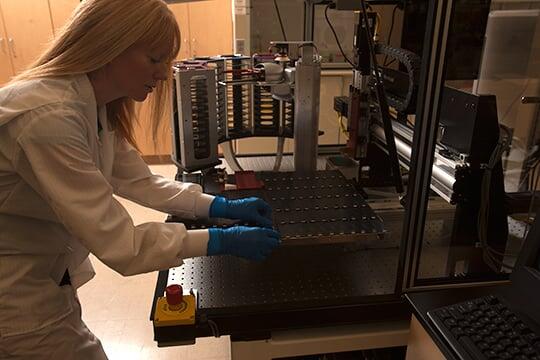The College of Sciences boasts a wide variety of facilities on and off campus that provide students with resources and environments necessary for academic success. The information below allows you to get better acquainted with the facilities and laboratories available to science students.



Electron Microanalysis & Imaging Laboratory (EMiL)
The Electron Microanalysis & Imaging Laboratory is an analytical laboratory dedicated to the solution of problems using electron micro-beam techniques for clients in industry, government agencies, and academia. EMiL is capable of providing microanalysis and imaging services.
Genomics Core Facility
The Genomics Core Facility aids in the development and support of genomics-based research. It provides equipment and training for DNA microarray handling, Western blot/gel/microarray scanning, PCR amplification, and analysis of DNA, RNA, and protein samples. The facility is located in the Science and Engineering Building, Rooms 3122, 3123, and 3124.
Las Vegas Isotope Science Laboratory (LVIS)
The Las Vegas Isotope Science Laboratory is equipped for analyses of water and geologic and biologic samples for oxygen, hydrogen, carbon, and nitrogen stable isotopes. These stable isotopes are powerful tracers of natural processes, ranging widely from tracking of bird migrations to studies of trophic levels and paleoclimate.
Nevada Extreme Conditions Lab (NEXCL)
The Nevada Extreme Conditions Lab (NEXCL) is a multidisciplinary group that explores fundamental experimental, computational, and engineering problems of materials under high pressure.
Nevada Isotope Geochronology Laboratory (NIGL)
The Nevada Isotope Geochronology Laboratory offers facilities to conduct 40Ar/39Ar dating. The geoscience department operates mineral separation facilities. The department also has a hydrology research group that focuses on surface and groundwater modeling projects.
Science and Engineering Building (SEB)
The Science and Engineering Building, a state-of-the-art building, is a unique environment for interdisciplinary research and education on the UNLV campus. The building’s innovative design supports collaboration among faculty in the sciences, engineering, health sciences, and other university research units.
Wesley E. Niles Herbarium
Wesley E. Niles Herbarium is a collection of dried, pressed plant specimens mounted on archival-quality sheets of paper that are placed in folders and stored in cabinets. These specimens provide tangible documentation for the occurrence, distribution, and diversity of flowering plants, conifers, and mosses in the Southwestern desert regions of the United States, especially the Mojave Desert.